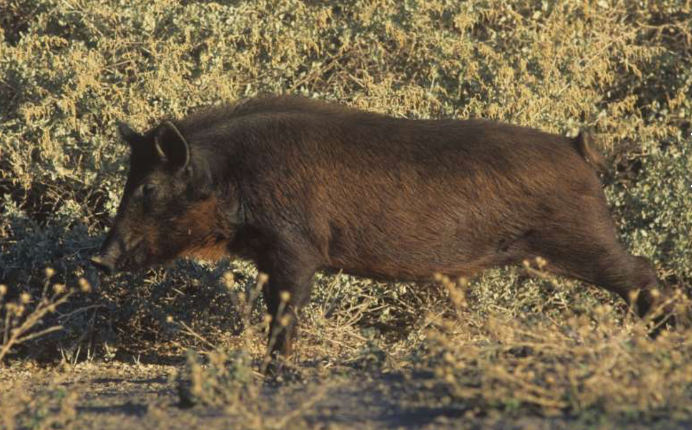The Wild Hogs of the California Hills
Adapted from Lafayette hires trapper to battle rampaging feral pigs By Mike Moffitt
California's wild pigs are massive and ubiquitous. They can grow into 200+pound ripping machines. They tear up lawns and destroy hillsides. Their gruesome teeth can even threaten humans and pets. And they're here, rooting up our landscaping, because of one mercurial millionaire.
Today's wild pigs are a hybrid breed, a mixture of two animals that have no place in California. The first is the standard domesticated pig, introduced by Spanish colonizers in the mid-1700s. Russian immigrants also apparently let some loose near Fort Ross in Sonoma in the 1800s. And as Gold Rush settlers flowed into the state, they killed the hogs’ biggest predator, the bear. So the once-domestic pig spread, becoming a feral pig out in the wild.
But it wouldn’t meet its love match until the 1920s, when George Gordon Moore imported the first European wild boar.
Moore was born in Wyoming, Canada in the 1880s and got his law degree by age 21. He practiced for a few years before growing bored and switching to finance. He quickly acquired a reputation as a shrewd financier in Europe and, oddly, a war tactician. According to a 1941 society column in the San Francisco Chronicle, he advised British Field Marshal John French during World War I. “He was the man most responsible for the failure of several of the last German drives,” the Chronicle wrote.
After the war, Moore moved to San Francisco where he quickly began using his millions to fund his twin passions: horses and hunting. He opened the San Mateo Polo Club, the spot to see and be seen for Bay Area elite. But that wasn’t enough for the ostentatious Moore: In 1923, he purchased a 20,000 Carmel Valley estate to create a theme park for the wealthy. Rancho San Carlos cost $400,000 (over $6 million in today’s money) and Moore reportedly sank over one million more into improvements. He built polo grounds, a lake and planned on adding a golf course. In the massive hacienda, he added a bedroom for each of the polo players on the international traveling team he funded. And, of course, he started setting European wild boars loose on the property for hunting excursions.
The height of the Bay Area social scene was getting an invitation to Rancho San Carlos. Barbecues and weekend soirees made the local newspapers regularly, attended by Hollywood stars and newspaper magnate William Randolph Hearst. “A retinue of servants, led by a huge, handsome Jamaican, served [Moore] night and day,” a 1941 Chronicle story boasted. “Sleep was something unheard of on the ranch,” it added.
Soon, Moore’s European boars encountered the feral pig population and began breeding, creating the California wild pig hybrid we see today. They loved the ecosystem, finding plenty of grasses, fruits and tubers to eat. Less than 10 years after being introduced, Moore’s wild hogs were seen up to 40 miles away. In 1936, the Chronicle reported hunters finding rubbings against a tree left by a hog that were over four feet high; that meant the hog weighed over 600 pounds. In a letter written in 1963, Moore recalled the biggest boar he’d ever hunted down: “When hung, [it] measured 9 ft. from tip to tip. The skin on his neck was three inches thick; eleven bullets were found which over the years had been imbedded in the fat.”
But those were the halcyon days for Moore. When the Great Depression hit, Moore was wiped out. In 1934, newspapers were reporting he was down to his last $1,000. The year before, he’d been sued by the Pacific Telephone and Telegraph Company for unpaid bills; the Oakland Tribune said he was spending $12,000 a month on long-distance calls — a mind-boggling $235,000 today.
It was the end of Rancho San Carlos. Moore lost it in a foreclosure, and it was purchased in 1940 by Arthur C. Oppenheimer of San Francisco and turned into a cattle ranch. Today, it’s become the Santa Lucia Preserve. Wild hogs still roam the hills.
Moore lived out the rest of his life, quietly, in Los Angeles, although his World War II draft card indicates he still kept up high-profile friendships. His emergency contact was a friend who lived at the Bohemian Club in San Francisco. He also ran into old pal William Randolph Hearst some decades after their escapades at Rancho San Carlos.
"Your pigs have reached San Simeon,” Moore recalled Hearst telling him. There was one more animal Moore set loose on California — although this one didn’t proliferate like his boars. In 1938, the Santa Cruz Sentinel reported a 200-pound brown bear broke into a cabin in Big Sur. It climbed through a window, ate the groceries and scattered flour everywhere, breaking furniture as it went. It was shot and killed by the bewildered homeowner, who then turned himself into the Monterey justice of the peace for hunting a bear out of season.
The official ruled “game laws don’t apply to bears in houses.” And in any case, the bear wasn’t native to the area. Locals had a pet theory, though.
They all figured it came from Moore’s long-lost menagerie.
Massive evidence of feral pig incursions are commonly seen along the trails of the Quick ranch. A depredation permit (Permit #: P-2021-000245) is in place with the California State Department of Fish and Wildlife.
